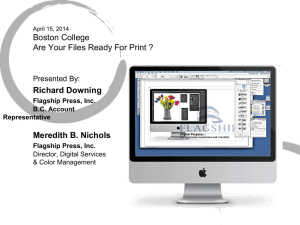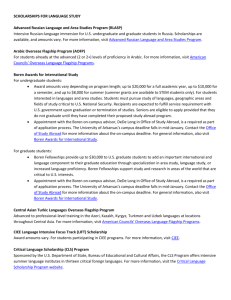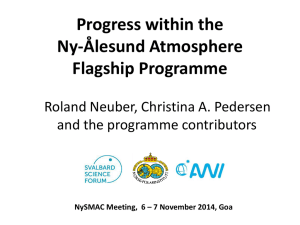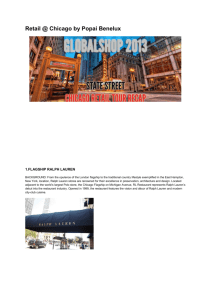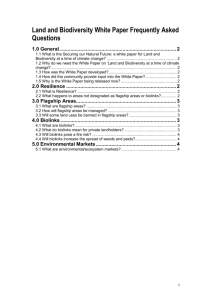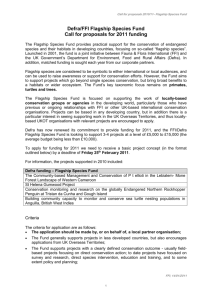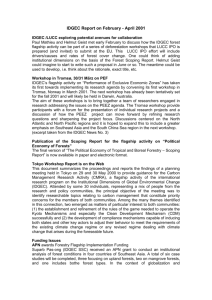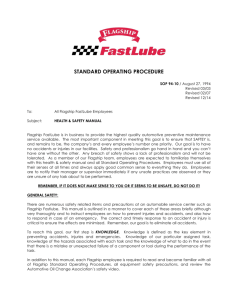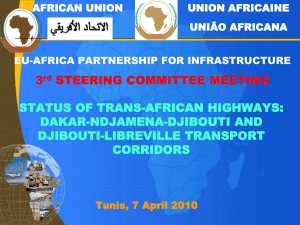The Language Flagship Undergraduate Model: Latest Results
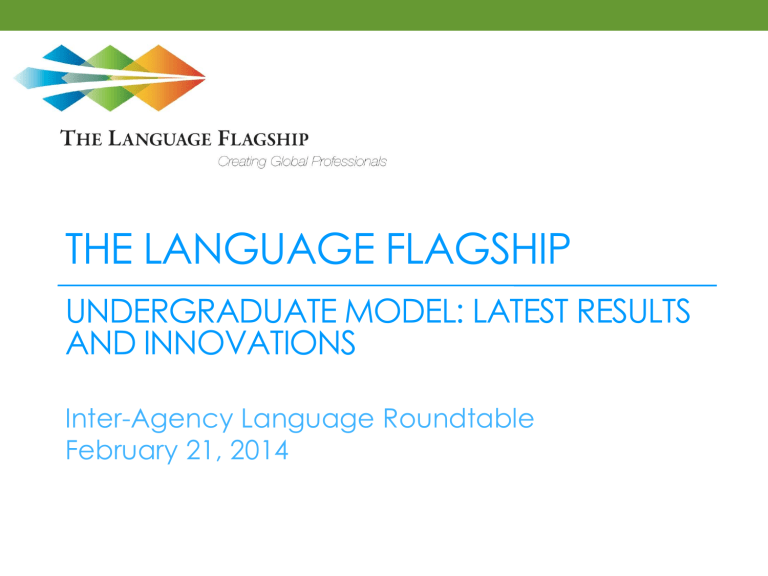
THE LANGUAGE FLAGSHIP
UNDERGRADUATE MODEL: LATEST RESULTS
AND INNOVATIONS
Inter-Agency Language Roundtable
February 21, 2014
DLNSEO
•
•
•
•
•
In 2012, the Defense Language and National Security Education
Office (DLNSEO) was created.
The new DLNSEO organization merged the National Security
Education Program and the Defense Language Office, to tackle the following Mission Areas:
Building a Talent Pipeline
Enhancing Workforce Readiness
Improving Testing and Assessment
Creating Surge Capability
Regional Alignment
DLNSEO ORGANIZATION
Leads the nation in recruiting, training, sustaining, and enhancing language and culture capabilities to ensure national and defense readiness by:
•
•
Building a highly-qualified pool of U.S. citizens with foreign language capabilities and international expertise committed to public service through programs and policies;
Leading the Department of Defense’s strategic policy planning in foreign language, culture, and regional expertise; and
•
Providing programmatic oversight of high-value national security and Defense training and education
NSEP INITIATIVES
•
African Languages Initiative (AFLI)
•
Boren Scholarships
•
Boren Fellowships
•
The Language Flagship
•
Flagship/ROTC Pilot Initiative
•
Project Global Officer (Project GO)
•
Language Training Centers
•
English for Heritage Language Speakers
•
National Language Service Corps
THE LANGUAGE FLAGSHIP
Flagship Overview
LANGUAGE FLAGSHIP HISTORY
•
•
•
•
Funded as an initiative beginning in 2001 through the
National Security Education Program (NSEP) of the
U.S. Department of Defense.
Flagship Domestic and Overseas programs have been operating since 2002.
Flagship announced transition from a post B.A model to an Undergraduate program in 2006
Flagship awarded the last Flagship Fellowship in 2011
THE LANGUAGE FLAGSHIP
The Language Flagship now boasts 26 Flagship Centers at 22 institutions, providing a pathway to professional-level proficiency across 10 languages: Arabic, Chinese, Hindi, Korean, Persian,
Portuguese, Russian, Swahili, Turkish and Urdu.
Currently, there are nearly 900 registered Flagship
Undergraduates, and another 1,100 students who are participating in Flagship courses.
We seek to empower a small but expanding group of innovators to develop and implement new models of undergraduate language learning and to diffuse these models throughout higher education. Flagship’s aim is to lead a national movement that will impact students throughout the nation.
THE LANGUAGE FLAGSHIP GOAL
•
Goal: To create a pool of college graduates from all majors with professional proficiency (ILR Level 3, ACTFL Superior) in critical languages to create the next generation of global professionals, and to change the expectations for foreign language learning in the United States.
THE LANGUAGE FLAGSHIP
The Undergraduate Model
THE FLAGSHIP DIFFERENCE
•
•
•
•
Expectation of Success
Coordinated domestic interventions that go beyond language classroom, including:
•
•
•
•
Group tutoring and individual tutoring
Guided co-curricular and extra-curricular activities
Content-based instruction throughout domestic program
Semi-autonomous learner tools
Rigorous assessment tied to anticipated learner outcomes
Common program goal of ACTFL Superior/ILR 3 proficiency and
“Flagship Certification”
FLAGSHIP PATHWAYS
K-12
Absolute Beginner, Heritage, Flagship K-12, StarTalk, NSLI-Y
Pre-Collegiate Flagship College Transfer
Domestic Undergraduate
Flagship Program
Domestic
Summer Intensive
Overseas
Summer Intensive
Overseas Flagship
Center
PROFESSIONAL LANGUAGE PROFICIENCY
Flagship Certified Global Professionals
DOMESTIC FLAGSHIP PROGRAM
•
•
•
•
•
•
Intensive and articulated language instruction on home campus
Guided interventions designed to ensure exposure and compel practice in target language
Weekly group and individual tutoring
Integrated content-based instruction and courses across disciplines
Immersive learning environments, such as language houses
Cultural functions and events, which compel students to use and improve their language
DOMESTIC FLAGSHIP PROGRAMS
•
•
•
•
•
Arabic
Michigan State University
University of Arizona
University of Maryland, College Park
University of Oklahoma
University of Texas, Austin
•
•
•
•
•
•
•
•
•
Chinese
Arizona State University
Brigham Young University
Hunter College
Indiana University
San Francisco State University
University of Mississippi
University of Oregon
University of Rhode Island
Western Kentucky University
•
•
•
Chinese Flagship/ROTC
Arizona State University
Georgia Institute of Technology
University of North Georgia
•
Hindi Urdu
University of Texas, Austin
•
Korean
University of Hawai'i, Manoa
•
Persian
University of Maryland, College Park
•
Portuguese
University of Georgia, Athens
•
•
•
•
Russian
Bryn Mawr College
Portland State University
University of California, Los Angeles
University of Wisconsin, Madison
•
Swahili
Indiana University
•
Turkish
Indiana University
OVERSEAS FLAGSHIP PROGRAM
•
•
•
•
All Domestic Flagship students are trained to meet the standards for participation in a Flagship Overseas Center experience.
All applicant Flagship students must take the Flagship battery of assessments.
Flagship students must meet the minimum proficiency of ILR
Level 2 or ACTFL Advanced in two modalities to be accepted to a Flagship Overseas Center experience.
Student applications are reviewed by language-specific academic councils that ensure their preparedness for the program.
OVERSEAS COMPONENTS
•
•
•
•
•
Core Requirements
Intensive directed language training in small groups
Direct enrollment courses related to student’s domestic major
Meaningful professional internships and work experiences
•
•
Required Support Components
Overseas Flagship Centers housed with peer universities
Integrated homestays to maximize language use and integrated cultural program
Regular weekly meetings with peer tutor and guided discussion groups with native speakers
On-going evaluation (testing, site visits, teacher/tutor reports, portfolio development, self-evaluation), including bi-weekly
Language Utilization Reports
OVERSEAS FLAGSHIP PROGRAMS
•
•
•
•
•
Ankara University, Turkey*
Jaipur Hindi Center, India
Lucknow Urdu Center, India
Korea University, South Korea
Arab-American Language Institute in Morocco (AALIM) in partnership with Moulay Ismail University, Morocco*
•
•
•
•
Nanjing University, China**
Sao Paulo State University, Brazil
St. Petersburg State University, Russia*
Tianjin Normal University, China*
University of Zanzibar, Tanzania*
•
* Administered by American Councils for International Education
** Administered by American Councils for International Education and
Brigham Young University
FLAGSHIP DEVELOPMENTS 2013
•
•
•
•
•
Welcomed first Flagship students to University of Arizona’s
Arabic Flagship Program
First Portuguese Flagship Students completed study in Brazil
Launched a second site in Chinese with opening of Flagship
Overseas Center at Tianjin Normal University
Implemented new enhanced curriculum at the Chinese
Overseas Flagship Center in Nanjing
Late 2013 competition for one or more new Chinese Domestic
Flagship Programs, results to be announced by June 2014.
THE LANGUAGE FLAGSHIP
Flagship Program Initiatives
FLAGSHIP/BOREN SCHOLARS
•
•
Flagship students have successfully competed for David L. Boren
Scholarships. These Boren Scholarships provide students with resources to acquire language skills and experiences in areas critical to the security of our nation.
Flagship/Boren Scholars commit to using their skills in federal service
In 2013, NSEP awarded 20 Boren Flagship Scholarships for study at Overseas Capstone Centers
FLAGSHIP/ROTC
•
•
•
NSEP launched the Pilot Flagship/ROTC initiative in 2011 to improve access for ROTC students to Flagship program. This pilot addresses strategic need for military officers with highlevel language and culture expertise.
Three institutions participate in the pilot program: Arizona
State University, the Georgia Institute of Technology
(Georgia Tech), and University of North Georgia.
In 2013, The Air Force ROTC launched an ROTC/Language
Flagship initiative by awarding 15 scholarships to students studying Arabic, Chinese, Korean, Persian and Russian.
In 2013, Army ROTC Cadet Command issued a memo detailing Army ROTC Language Flagship Scholarship arrangements
THE LANGUAGE FLAGSHIP
Flagship Students
2006-2013 FLAGSHIP ENROLLMENTS
835
888 895
733
632
417
41
160
FINAL
06-07
FINAL
07-08
FINAL
08-09
FINAL
09-10
FINAL
10-11
FINAL
11-12
FINAL
12-13
FALL
13-14
ENROLLMENT BY LANGUAGE
Flagship
Language
Arabic
Chinese
Hindi Urdu
Korean
Persian
Portuguese
Russian
Swahili
Turkish
2010-2011
Enrollment
269
289
32
31
30
0
82
0
0
733
2011-2012
Enrollment
235
387
24
29
18
16
118
8
0
835
2012-2013
Enrollment
182
434
22
37
14
55
128
9
7
888
Fall 2013
Enrollment
159
443
27
48
12
55
121
21
9
895
OVERSEAS ENROLLMENTS
120
100
80
60
40
20
0
64
89
117
101
10-11 11-12 12-13 13-14
Arabic Chinese* Hindi Urdu
Korean Persian Portuguese*
Russian Swahili Turkish
* Total includes students who began Overseas Flagship Study in January 2014
MAJORS OF FLAGSHIP STUDENTS
5%
40%
55%
No Major Indicated One Major Only Two or More Majors
MAJORS OF FLAGSHIP STUDENTS
Business
Professional
12.9%
9.8% 10.4%
0.8%
32.8%
32.7%
0.6%
Education
Social Science
Humanities
STEM
THE LANGUAGE FLAGSHIP
Flagship Results
2013 HIGHLIGHTS
•
•
•
In 2013, 117 undergraduate students completed the Flagship
Overseas Capstone year.
All 117 Overseas Flagship undergraduate students were required to take a pre-capstone Oral Proficiency Interview (OPI) scored on the ACTFL scale, and post-capstone OPI score on the
ACTFL and ILR scales.
Flagship participants who achieved an ILR 3 or higher on the
OPI include students of Arabic (24), Chinese (26), Hindi (1),
Korean (6), Persian (1), Portuguese (4), Russian (16), and Swahili
(4).
2013 EXIT SPEAKING PROFICIENCY
100%
90%
80%
70%
60%
50%
40%
30%
20%
10%
0%
7%
2
26%
2+
65%
3
2%
3+
93%
2+ and
Above
2013 STUDENT SPEAKING GAINS
60
50
40
30
20
10
0
47
2
6
2
6
IM IH AL
Pre-Capstone (121)
44
17
16
38
4
AM AH
Post-Capstone (121)
S
58
20
15
10
5
0
2013 ARABIC SPEAKING GAINS
25
IL IM IH
Pre-Capstone
18
7
2 2 3
AL AM AH
Post-Capstone (ACTFL)
S
22
2013 CHINESE SPEAKING GAINS
25
23
20
22
15
15
10
9
5
0
IL IM IH
Pre-Capstone
6
5
AL AM AH
Post-Capstone (ACTFL)
4
S
2013 RUSSIAN SPEAKING GAINS
10
8
6
4
2
16
14
12
0
1
9
6
1
IL IM IH
Pre-Capstone
AL AM AH
Post-Capstone (ACTFL)
S
15
15
10
5
0
2013 ARABIC LISTENING GAINS
25
20 22
4
1+
12
11
5
3+
0
2 2+ 3
Listening Pre-Capstone (ILR) Arabic
Listening Post-Capstone (ILR) Arabic
2013 CHINESE LISTENING GAINS
30
25
20
15
10
5
0
28
5
0
1+
15
12
13
8
0
2 2+ 3
Listening Pre-Capstone (ILR) Chinese
Listening Post-Capstone (ILR) Chinese
0
1
3+
2013 RUSSIAN LISTENING GAINS
12
10
8
6
4
2
0
2
1+
8
6
5
1
0
2 2+ 3
Listening Pre-Capstone (ILR) Russian
Listening Post-Capstone (ILR) Russian
10
0
3+
2013 ARABIC READING GAINS
18
16
14
12
10
8
6
4
2
0
1
0
1
17
16
6
8
3
0
3
0
1+ 2 2+ 3
Reading Pre-Capstone (ILR) Arabic
Reading Post-Capstone (ILR) Arabic
0 0
3+
2013 CHINESE READING GAINS
30
25
20
15
10
5
0
29
11
22
12
0 0
1
0 0 3 0
1+ 2 2+ 3
Reading Post-Capstone (ACTFL) Chinese
Reading Post-Capstone (ILR) Chinese
0 0
3+
2013 RUSSIAN READING GAINS
16
14
12
10
8
6
4
2
0
15
1
7 7
1 1+ 2 2+ 3 3+
Reading Pre-Capstone (ILR) Russian
Reading Post-Capstone (ILR) Russian
4
2
2013 FSI TESTING
•
•
Of the 117 undergraduate students who completed the Flagship
Overseas Capstone year - 17 students took an FSI oral proficiency test, with:
Speaking
•
100% (17) scoring at or above ILR Level 2+,
•
59% (10) scoring at ILR Level 3 or higher, and
•
•
18% (3) scoring at ILR Level 3+ or higher.
Reading
Of the 17 students - 6 (38%) received an ILR Level 3 or higher on their FSI reading assessment and 11 (69%) received an ILR level 2+ or higher on their FSI reading assessment.
2013 FSI SPEAKING RESULTS
8
7
6
5
4
3
2
1
0
7 7
2
2 2+ 3 3+ 4
1
4+
2013 DLPT TESTING
•
•
2013 returning Boren/Flagship Scholars took the Defense
Language Proficiency Test for listening (13) and reading (12) skills.
The results for the students tested are:
Listening
•
•
•
75% (9) scored an ILR 2+ or higher in listening, and
42% (5) scored an ILR 3 in listening
Reading
85% (10) scored an ILR 2+ or higher in reading, and
38% (4) scored an ILR 3 in reading
•
2013 DLPT RESULTS
7
6
5
4
3
2
1
0
1 1
1+
6
4
5
4
2
1
2 2+ 3
DLPT Reading DLPT Listening
3+
1
2013 GOVERNMENT TESTING
•
Looking at all the students tested either by FSI, DLPT or both – of that total:
•
• 87% of the students tested demonstrated professional proficiency in at least one modality on either the FSI or DLPT tests, and
100% of the students tested demonstrated working proficiency in at least one modality on either the FSI or the
DLPT test.
THE LANGUAGE FLAGSHIP
Flagship K-12 Investments
K-12 DEVELOPMENTS - CHINESE
•
Flagship – Chinese Acquisition Pipeline (F-CAP):
•
Consortium managed by BYU and the State Education Office of Utah reaching state and local educational agencies and
Flagship institutions across 20 states
•
•
Promoting dual-language Chinese immersion at the elementary level and articulated Chinese language and content learning for middle and high school levels.
Piloting AAPPL proficiency assessments for high school students studying Chinese at levels 2 (video chat only), 3, and
4 (complete battery) state-wide in Utah and South Carolina, and within several local education agencies across the U.S.
K-12 DEVELOPMENTS - CHINESE
•
Portland Public Schools (PPS):
•
Over 1200 students in elementary through high school duallanguage immersion and articulated middle and high school programs
•
•
Fully integrated assessment (87% of 8th graders Intermediate
Mid or higher; 25% HS grads at Advanced Low or above for
2011-2012)
To date, 45 students from PPS program have matriculated into the University of Oregon Chinese Language Flagship. Of these students, 17 entered with Advanced-level Chinese language proficiency, 24 Intermediate, and four with Novice proficiency.
K-12 DEVELOPMENTS – ARABIC
MSU Arabic Curriculum Project
•
•
•
•
Created a flexible standards-based, 32 thematic unit curriculum for secondary learners. Now developing a third level with 16 additional units.
75 teachers in 17 states have received professional development on the curriculum.
60 learners through Level 2 in three locations assessed this
May on AAPPL.
Levels 1 and 2 are now available online: http://elogin.najjtech.com/
THE LANGUAGE FLAGSHIP
ASSESSMENT
DATA AND RESULTS
•
•
•
•
Flagship Model relies on data for constant feedback and improvement
Flagship reports annually our results to Congress, the National
Security Education Board, and the public.
We must have timely data from reliable proficiency assessments
Using the Student Certification System and the Flagship
Performance Report, Flagship is able to report easily on enrollments and student support.
ASSESSMENT INVESTMENT
•
•
•
Since 2005, The Language Flagship has made significant investments in innovative Foreign Language Proficiency
Assessments that can be used in the higher education and overseas language study environments.
By the end of 2014, The Language Flagship will establish ILRscored testing batteries in Speaking, Reading and Listening across all 10 Flagship languages, with capacity to administer online writing rubrics as well.
Partners in developing, improving, and delivering assessment instruments for Flagship programs include American Councils for
International Education, ACTFL/LTI, University of Texas, Austin, and Brigham Young University.
•
•
FLAGSHIP PROFICIENCY ASSESSMENT
PROTOCOL – OVERSEAS CAPSTONE
High Stakes Testing is implemented for Flagship Capstone
Overseas pre-program selection and post program certification:
Speaking: All overseas capstone participants must score at ILR
2 or above on the pre-program OPI delivered by ACTFL/LTI. For
Flagship certification: students must score an ILR 3 in speaking on the post-program OPI delivered by ACTFL/LTI.
•
•
FLAGSHIP PROFICIENCY ASSESSMENT
PROTOCOL – OVERSEAS CAPSTONE
Reading and Listening: Online reading and listening tests developed by American Councils are delivered as pre- and post-program tests for students in the Arabic, Chinese, Persian,
Russian and Swahili capstone programs. By end of 2014,
Flagship will implement similar instruments for Hindi, Korean,
Portuguese, Turkish and Urdu. Students must demonstrate ILR 2 ability in Reading or Listening and no less than ILR 1+ for admission to Capstone
Writing: Writing samples are examined by selection committees to ensure writing proficiency sufficient to participate effectively in classes at overseas partner universities.
•
•
FLAGSHIP PROFICIENCY ASSESSMENT
PROTOCOL – OVERSEAS CAPSTONE
Host Country Testing
Overseas Programs also integrate official Host Country language testing to assist students in academic and internship placements and to gauge progress according to local testing standards. These tests include:
•
•
•
•
Common European Framework of Reference for Languages
(CEFR – Turkey)
Hàny ǔ Shu ǐ píng K ǎ oshì (HSK – China)
Test of Proficiency in Korean (TOPIK – South Korea)
Test of Russian as a Foreign Language (TORFL – Russia)
•
•
•
FLAGSHIP PROFICIENCY ASSESSMENT
PROTOCOL – SUMMER PROGRAMS
Chinese Overseas Summer Programs: All sponsored Flagship students participating in intensive Chinese language overseas summer programs take the ACTFL scaled online reading and listening tests developed by BYU for pre- and post-program proficiency assessment.
UT Austin Domestic Intensive Arabic Language Summer
Program: All sponsored Flagship students participating in the UT
Austin summer Arabic language program take the ACTFL scaled online reading and listening tests developed by UT
Austin and BYU for pre- and post program assessment.
All funded Flagship summer intensive language experiences are required to provide pre- and post program testing data from approved assessment instruments
•
FLAGSHIP PROFICIENCY ASSESSMENT
PROTOCOL – DOMESTIC PROGRAMS
Flagship Domestic Programs integrate a variety of proficiency testing mechanisms and related assessments to mark progress through a student’s career. Commonly used testing instruments include:
•
•
Formal and Informal OPI’s
Flagship sponsored assessment instruments
•
•
•
Host Country Instruments (HSK, TOPIK, etc)
Linguafolio and other portfolio assessment instruments
Other available proficiency tests
2013 ASSESSMENT DEVELOPMENTS
•
•
•
American Councils Reading and Listening online assessments available June 2014: Hindi, Korean, Portuguese, Turkish and
Urdu
Agreement with ACTFL/LTI to score Flagship Capstone OPI’s on
ILR scale
Discussion on multi-dialect OPI testing for Arabic Flagship
Capstone students in Morocco learning Egyptian and
Moroccan dialects along with MSA.
STUDENT CERTIFICATION SYSTEM
•
Student Certification System (SCS) is a tool designed to track the progress of Flagship Undergraduate students and provide timely data on enrollment, assessment and program completion.
•
SCS is the sole mechanism used for Flagship Certification –.
•
The system currently has collected data on more than 1,300
Flagship Undergraduates, Flagship Alumni, and Flagship
Certified students.
•
The system is undergoing a series of improvements, enhancements and data cleaning/verification exercises.
STUDENT CERTIFICATION SYSTEM
FLAGSHIP/NFLC e-LEARNING PORTAL
•
•
•
•
Flagship and National Foreign Language Center collaboration to create an e-learning portal
Small investment made available over 11,000 learning and assessment objects to be used by learners and programs nationally.
Flagship/NFLC e-learning portal has available more than 100 objects for each of Flagship languages.
The Flagship Community lead by the Language Councils is determining how best to use this resource, and make them available to Flagship students.
FLAGSHIP/NFLC e-LEARNING PORTAL
2014 FLAGSHIP WEBSITE REDESIGN
www.thelanguageflagship.org
LANGUAGE FLAGSHIP GRANTEES
ARABIC
Michigan State University
University of Arizona
University of Maryland
University of Oklahoma
University of Texas, Austin
Moulay Ismail University,
Morocco*
CHINESE
TBA
Arizona State University**
Brigham Young University
Georgia Institute of
Technology**
Hunter College
Indiana University
University of North Georgia**
San Francisco State University
University of Mississippi
University of Oregon
University of Rhode Island
Western Kentucky University
Nanjing University, China***
Tianjin Normal University, China*
HINDI URDU
University of Texas, Austin
Jaipur Hindi Flagship Center, India
Lucknow Urdu Flagship Center,
India
KOREAN
University of Hawaii, Manoa
Korea University, South Korea
PERSIAN
University of Maryland
PORTUGUESE
University of Georgia, Athens
Sao Paulo State University, Brazil
RUSSIAN
Bryn Mawr College
Portland State University
University of California, Los
Angeles
University of Wisconsin, Madison
St. Petersburg State University,
Russia*
SWAHILI
Indiana University
State University of Zanzibar,
Tanzania*
TURKISH
Indiana University
Ankara University, Turkey*
* Overseas Center managed by
American Councils for
International Education
** Pilot Flagship/ROTC Centers
*** Overseas Center managed by Brigham Young University and
American Councils for
International Education
THE LANGUAGE FLAGSHIP
The Future of Flagship
PROJECTS IN DEVELOPMENT
•
In 2014, The Language Flagship will announce new award(s) for
Chinese Domestic Flagship Centers.
Currently under way are two competitions, these include:
“Comprehensive Survey of U.S. Foreign Language Enrollments:
K-12 and Higher Education”; and
•
“The Language Flagship Proficiency Initiative” to support projects that integrate Flagship proficiency assessment practices.
Both of these research initiatives add significantly to the information required to improve the foreign language field.
FLAGSHIP CHALLENGES
•
•
•
•
•
•
Continuing Challenges
Increasing Enrollment in Domestic and Overseas;
Documenting improvements in the Flagship Undergraduate
Model;
Improving the collection of results and the analysis of that data;
Increasing the number of Flagship students completing federal service through Boren awards and ROTC;
Institutionalizing the Flagship model on campuses, and
Disseminating the model nationally.
FLAGSHIP STUDENT TESTIMONIALS
“After the Flagship Capstone Year I have become much more confident in all aspects and am now very comfortable with the language to a point that I feel I will be able to utilize my language skills in the professional world.”
“I have gone from zero knowledge of my Flagship language to superior-level proficiency in under four years of study.”
“The commitment I made to Flagship, both domestically and overseas, shaped my interest in the international realm and made me a more attractive job candidate. Working for the U.S.
Department of Treasury allows me to combine my strengths and passions and improve people’s lives through my federal service.”
